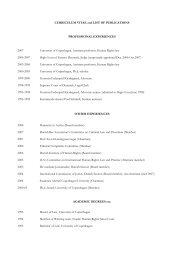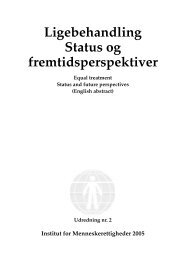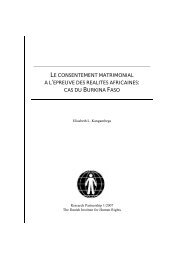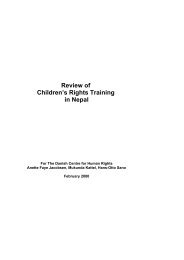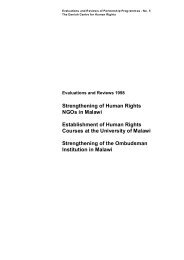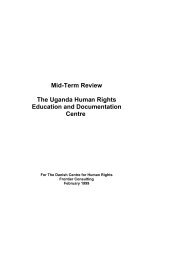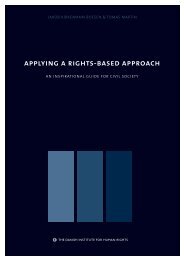JS2 – Joint report 2 (pdf) - Danish Institute for Human Rights
JS2 – Joint report 2 (pdf) - Danish Institute for Human Rights
JS2 – Joint report 2 (pdf) - Danish Institute for Human Rights
You also want an ePaper? Increase the reach of your titles
YUMPU automatically turns print PDFs into web optimized ePapers that Google loves.
UNIVERSAL PERIODIC REVIEW <strong>–</strong> DENMARK 2011<br />
JOINT SUBMISSION <strong>–</strong> GREENLAND NGOS<br />
RELATIVE TO THE 1 ST UNIVERSAL PERIODIC REVIEW OF DENMARK MAY 2011<br />
REGARDING: INDIGENOUS/HUMAN RIGHTS AND POWERS OF PUBLIC GOVERNMENT<br />
THE SITUATION OF THE INDIGENOUS COMMUNITY OF THE THULE DISTRICT.<br />
THE “LEGALLY FATHERLESS”<br />
SUBMITTED BY: AQQALUK LYNGE, CHAIR, INUIT CIRCUMPOLAR COUNCIL, GREENLAND<br />
THE ASSOCIATION HINGITAQ 1953 (THE OUTCASTS 1953), THULE, GREENLAND.<br />
AND THE KATTUFFIK ATAATA (THE ASSOCIATION FATHERS)<br />
1. Inuit Circumpolar Council (ICC) Greenland is the Greenland chapter of ICC, which is an<br />
indigenous peoples’ organization (IPO) representing the rights and interests of Inuit in Chukotka,<br />
Alaska, Canada, and Greenland. ICC Greenland speaks out on international policy and<br />
development matters that have an impact on Inuit within Greenland, and internationally in matters<br />
such as human rights, environment and climate change. In accordance with Article 71 of the UN<br />
Charter the Inuit Circumpolar Council is also an international NGO recognized by ECOSOC. In<br />
2006 ICC changed its name from the Inuit Circumpolar Conference to the present Inuit<br />
Circumpolar Council.<br />
2. There is no National <strong>Human</strong> <strong>Rights</strong> Institution (NHRI) <strong>for</strong> Greenland. The <strong>Danish</strong> <strong>Institute</strong> <strong>for</strong><br />
<strong>Human</strong> <strong>Rights</strong> does not cover Greenland and the Faroe Islands, in accordance with its enabling act<br />
no. 411 of 6 June 2002, Section 13. The ICC in accordance with its Charter has promoted Inuit<br />
rights by regularly participating in UN human rights ef<strong>for</strong>ts <strong>for</strong>m the early 1980s and since 1996<br />
the ICC has contributed in<strong>for</strong>mation to UN treaty bodies <strong>for</strong> their consideration of periodical<br />
<strong>report</strong>s from the Government of Denmark on the implementation of the ICERD and ICCPR<br />
conventions. ICC is also a permanent participant to the Arctic Council. The ICC is an umbrella<br />
organization, and the Delegation of Greenland to the General Assembly counts representatives of<br />
15 organisations, from Youth Associations, over Cultural and Sports Organisations, Labour and<br />
Hunter’s and Fisher’s Associations, the Inughuit of the Thule District, Political Parties,<br />
Municipalities, , Women and Elders.<br />
3. Following in<strong>for</strong>mation from the ICC, the <strong>Human</strong> <strong>Rights</strong> Committee in 1996 took note of the<br />
pledge by the <strong>Danish</strong> delegation that the text of the Covenant would be translated into Greenlandic<br />
and published. (CCPR/C/Add.68, para. 8) and subsequently ICERD (see CERD/C/408/Add.1,<br />
para 128). Prior to a hearing on the UPR process organized by the Ministry of Foreign Affairs and<br />
the Self-Government on 25 Oct. 2010 in Nuuk the ICC had prepared a Greenlandic translation of<br />
the Paris Principles.<br />
4. On the balance, there has not been equal access to in<strong>for</strong>mation, knowledge, provision, enjoyment<br />
and protection of human rights between Denmark and Greenland and their native right holders.<br />
Also resources <strong>for</strong> human rights work has been distributed unevenly, and on this background it is<br />
un<strong>for</strong>tunate, that the <strong>Danish</strong> Government in the Spring of 2009 has decided to stop contributions<br />
of some ½ million DKR/year by medio 2011 <strong>for</strong> ICCs participation at the UN <strong>for</strong> Inuit and<br />
indigenous rights. The amount may appear unimportant in the <strong>Danish</strong> appropriations system, but<br />
will have serious impact <strong>for</strong> the ICC and <strong>for</strong> capacity-building in human rights work.<br />
1
5. The ICC would like to draw attention to the voluntary pledges of the <strong>Danish</strong> Government in<br />
accordance with G.A. Resolution 60/251, when Denmark was a candidate <strong>for</strong> a seat on the <strong>Human</strong><br />
<strong>Rights</strong> Council. In her document Denmark committed itself, inter alia, to advance human rights<br />
internationally:<br />
“By working to strengthen the implementation of international human rights instruments,<br />
including the United Nations declaration on the <strong>Rights</strong> of Indigenous Peoples.”<br />
and pledged “to ensure effective enjoyment of human rights domestically:<br />
…By submitting fully to independent monitoring of human rights protection domestically<br />
through cooperation with international and national monitoring bodies as well as by complying<br />
with their recommendations." 1<br />
6. ICC recognizes the important contributions of both the <strong>Danish</strong> Government and the Greenlandic<br />
authorities towards both the UN Declaration on the <strong>Rights</strong> of Indigenous Peoples and the ILO<br />
Convention 169 on Indigenous and Tribal Peoples, but regrets to note serious gaps in<br />
implementation, especially when it comes to land rights and to self-identification as indigenous.<br />
Thus, the <strong>Human</strong> <strong>Rights</strong> Committee in 2008 noted with concern the failure of the Supreme Court<br />
in November 2003 to recognize the Thule Tribe of Greenland as a separate group capable of<br />
vindicating its traditional rights, despite the tribe’s own perception to the contrary”, and in August<br />
2010 CERD recommended that notwithstanding the decision of the Supreme Court, the State party<br />
should adopt measures to ensure that self identification is primarily used in determining whether a<br />
people are indigenous or not. In this regard, the Committee recommends that the State party<br />
should adopt concrete measures to ensure that the status of the Thule Tribe reflects established<br />
international norms on indigenous peoples’ identification. 2<br />
7. Un<strong>for</strong>tunately, the Government has consistently opted not to comply with the conclusions and<br />
recommendations of the Treaty Bodies, contrary to the pledge above. In the Sections below, the<br />
ICC shall first comment on the uneasy relationship between the concept of ‘peoples’, ‘indigenous<br />
people’ and ‘indigenous communities’ and the apparent confusion between public powers of<br />
government and human rights (Section I), which has made it difficult to reach a sustainable<br />
solution on traditional land rights in the Thule Case and discriminates in access to protection of<br />
indigenous property (Section II). Finally, in Section III, a long standing issue of legally fatherless<br />
is reviewed, concerning unfavourable treatment and status of children born out of wedlock by<br />
Greenlandic mothers. Proposed questions are offered at p.10.<br />
I. An uneasy relationship: Indigenous rights and public government<br />
8. When Greenland attained home rule in 1979 it was a beginning of a devolution process that<br />
transferred powers from the <strong>Danish</strong> central Government to a new central government entity in<br />
Greenland. This process is continuing with the present Greenland Self-Government. This transfer<br />
of powers <strong>–</strong> important as it is - moved government closer to the population in Greenland, but did<br />
not vest human rights or indigenous rights of the Inuit in Greenland in the system of public<br />
Government <strong>–</strong> a fact that tends to be overlooked.<br />
9. The Home Rule Act <strong>for</strong> Greenland transferred certain administrative and legislative powers from<br />
the central state government to a regional authority, but did not change the legal position of the<br />
inhabitants. Thus by Section 10 and 19 of the Home Rule Act/Section 16 and 28 of the Self-<br />
1 Note verbale dated 2 February 2007 from the Permanent Mission of Denmark to the United Nations addressed to<br />
the President of the General Assembly. UN Doc. A/61/742, Agenda item 105 (2) …election of fourteen members of the<br />
<strong>Human</strong> <strong>Rights</strong> Council.<br />
2 See CCPR/C/DNK/CO/5 respectively CERD/C/ DNK/CO/18-19. An overview of Concluding Observations by the<br />
Committee on the Elimination of Racial Discrimination and the <strong>Human</strong> <strong>Rights</strong> Committee 1996-2010 in respect of the<br />
Thule case on indigenous land rights, <strong>for</strong>ced removal and the existence of the Inughuit as a separate indigenous entity is<br />
appended to the present document.<br />
2
Government Act, important provisos are established providing <strong>for</strong> the respect of the home<br />
rule/self-government authorities regarding international obligations that are binding on the Realm<br />
(Sections 10/16) and existing valid law and protections which remained in <strong>for</strong>ce until amended or<br />
repealed by the appropriate authority. Thus, the Home Rule/Self Government Acts must be<br />
construed in a way that does not limit or derogate from any existing human rights or fundamental<br />
freedoms under any of the laws or any other agreement or international obligation to which the<br />
State and its authorities is a party.<br />
10. Secondly, The Home Rule Act was not an act of expropriation, and accordingly it did not purport<br />
to deprive anyone arbitrarily (Universal Declaration of <strong>Human</strong> <strong>Rights</strong>, Art. 17) of their right to the<br />
peaceful enjoyment of his or her possessions <strong>–</strong> owned alone or in association with others of due to<br />
a requirement of “the public weal” (<strong>Danish</strong> Constitution, Section 73) or “in the public interest” (1 st<br />
Protocol of the ECHR, Art. 1). Thus, absent any intent to take, e.g. the rights of the members of<br />
the Thule tribe at the time of the adoption of the Home Rule Act, the applicants must be deemed<br />
to continue in the rights vested in the Thule Tribe and which still subsisted at the time of entry into<br />
<strong>for</strong>ce of the Act.<br />
11. There has, however, been a tendency to perceive home rule/self-government and its contribution<br />
towards the right of self-determination as securing in and by itself all human rights in Greenland.<br />
One may take as an example a hearing by the <strong>Danish</strong> Foreign Ministry on the draft UN<br />
Declaration on the rights of indigenous peoples. In the Reply by the <strong>for</strong>mer <strong>Danish</strong> Centre <strong>for</strong><br />
<strong>Human</strong> <strong>Rights</strong> it was noted that the draft declaration did not impact on the Home Rule system <strong>for</strong><br />
Greenland, “which on virtually all points fulfilled the requirements of the declaration”. It was<br />
there<strong>for</strong>e recommended, that Denmark in cooperation with the Nordic Countries worked <strong>for</strong> the<br />
adoption of the Declaration if and when it reached the General Assembly <strong>for</strong> consideration. 3<br />
12. There is an uneasy relationship between the concepts of “people” and “indigenous people” and<br />
“indigenous communities” and the relevant entities to exercise rights as such. The preamble to the<br />
Self Government Act <strong>for</strong> Greenland of 2009 states that the “people of Greenland is a people in<br />
accordance with international law with a right to self-determination”. According to the<br />
explanatory remarks <strong>for</strong> the draft bill, “this implies inter alia that the Greenlandic people take<br />
decision on independence <strong>for</strong> Greenland”.<br />
13. In the Annex on Greenland of the 18 th <strong>Danish</strong> periodic <strong>report</strong> to CERD (CERD/C/DEN/18-19),<br />
para. 3 and 4 (p. 36) the Government notes the Supreme Court conclusion: that the Thule Tribe<br />
does not constitute a tribal people or a distinct indigenous people and refers to the <strong>Danish</strong><br />
declaration upon the ratification of the ILO Convention 169, that Denmark has “only one<br />
indigenous people”.<br />
14. On this matter the ICC should like briefly to note, that no reservations can be made to ILO<br />
Conventions, and the <strong>Danish</strong> declaration at the time of ratification of ILO C.169 has no status<br />
in international law. This fact was disregarded by the Supreme Court relying on the <strong>Danish</strong><br />
Declaration. This general rule regarding reservations was stated also by the Ad hoc<br />
Committee in its <strong>report</strong> on the SIK-complaint. 4 The first conclusion of the <strong>report</strong> reads:<br />
The Committee notes that the Declaration deposited with the ratification reflects the<br />
understanding of Government at the time that it ratified the Convention. It recalls that no<br />
reservations to the ratification of ILO Conventions are admissible and that, consequently,<br />
the Government's Declaration has no binding <strong>for</strong>ce. (para. 27)<br />
15. Secondly, the word “distinct” has no basis in the Convention 169, but was introduced by the<br />
3 <strong>Danish</strong> Centre <strong>for</strong> <strong>Human</strong> <strong>Rights</strong>, ltr. to the Foreign Ministry, dated 15 May 1995, Annex p. 5.<br />
4 ILO Doc. GB.280/18/5, March 2001, cf. text to n. 12, below.<br />
3
Government to suggest, that there could be only one community in Greenland which could claim<br />
rights under the convention, i.e. the Home Rule Government. However, the question of which<br />
entity can exercise indigenous rights is contextual, depending both on the type of right in question<br />
and also of actual or potential interference with that right <strong>–</strong> e.g. traditional land use is the basis <strong>for</strong><br />
the exercise of land rights and the right to make claims. Lands rights based in a local, indigenous<br />
entity may conflict with other governmental interests in resource development, which is the very<br />
reason <strong>for</strong> establishing protected rights.<br />
16. Thirdly, in the view of the ICC the existence of an indigenous community is a question of fact,<br />
and not an instrument of domestic law. This recalls the fundamental guidance of the Permanent<br />
International Court: “The existence of communities is a fact; it is not a question of law” (PCIJ,<br />
Greco-Bulgarian Communities Case, Ser. B, No. 17, p.22). Compare in this context also the<br />
General Comment No. 23 (1994) by the <strong>Human</strong> <strong>Rights</strong> Committee on the “existence” of<br />
minorities within a State and members of indigenous communities who exercise a “way of life<br />
which is closely associated with territory and use of its resources” (para. 5 and 3.2) and the<br />
previous concluding observations by CERD on Denmark adopted on 18 August 2006<br />
(CERD/C/DEN/CO/17, 19 October 2006, appended).<br />
17. The uneasy relation in the application of rights of indigenous communities or peoples in<br />
Greenland can also be seen in the fact, that the Greenlandic Home Rule Government acted as a<br />
third party intervener in the Thule case be<strong>for</strong>e the Supreme Court, whereas the Home Rule refused<br />
to support bringing the Thule case to the European Court of <strong>Human</strong> <strong>Rights</strong>, one reason being:<br />
“The Greenland Home Rule has furthermore not previously recognized that individuals or<br />
tribes may have special rights over parts of the Greenlandic territories, as the public have the<br />
ownership of land in Greenland.” 5<br />
18. Since there is no public acquisition of ownership of lands in Greenland, this brings into question<br />
the very character and effect of the original Inuit occupation and establishment of traditional land<br />
use in Greenland, and of the protections established in international law <strong>for</strong> indigenous peoples<br />
and communities. The Thule case exemplifies this problem.<br />
II. The Thule Case<br />
19. The Thule Tribe or the Inughuit (also known as the Polar Eskimos and by several other<br />
designations) and its members are the original occupants and possessors of the Northwestern part<br />
of Greenland, known as the Thule District. The Inughuit (plural nom. and gen. of Inughuaq) are<br />
one of several sub-groups or tribes of the Inuit (Eskimo) peoples inhabiting Arctic and Sub-arctic<br />
territories from Siberia, over Alaska, Canada and Greenland. Inughuit have a separate language<br />
<strong>for</strong>m and special cultural adaptation based on their harvesting the natural resources of their high<br />
arctic environment.<br />
20. By unilateral <strong>Danish</strong> decree no. 304 of 10 May 1921 the Thule District was incorporated into the<br />
<strong>Danish</strong> colonial area in Greenland and thereby under <strong>Danish</strong> sovereignty. (P.C.I.J. Ser. A/B, Fasc.<br />
53, Legal Status of East Greenland, p. 15, cf. Ser. C, No. 64, p. 1539 and Lovtidende 1921, A, nr.<br />
27, p. 1041). At the time of <strong>Danish</strong> colonization the Inughuit had <strong>for</strong> centuries been living as an<br />
organized society in their homelands and were the undisturbed and uncontested users of their<br />
hunting territory. This situation prevailed until the events <strong>for</strong>ming the interferences, which are the<br />
subject of the present section. At no time during colonization or after has the <strong>Danish</strong> government<br />
made pretensions to have abolished or acquired traditional, indigenous land rights in the territory.<br />
A special legal regulation <strong>for</strong> the area, The Thule Act, was established by the <strong>Danish</strong>/ Greenlandic<br />
explorer Knud Rasmussen as proprietor of a private trading station in the District in co-operation<br />
with a so-called Hunters’ Council in 1927 and adopted in 1929. The Thule Act was subsequently<br />
5 Letter dated 1 June 2004 from Greenland Premier Hans Enoksen to ICC Greenland.<br />
4
atified by the competent Minister on 8 September 1931 <strong>–</strong> cf. the authority in the Governance Act<br />
<strong>for</strong> Greenland of 1925 § 45, which incorporated relevant international law.<br />
21. The Thule case <strong>for</strong> present purposes refers to the establishment by agreement between Denmark<br />
and the U.S.A. of the U.S. Thule Air Base in 1951 in the centre of the hunting territory of the<br />
Inughuit - without prior consultation nor consent - and the subsequent expansion of the base and<br />
<strong>for</strong>ced relocation of the central community village in 1953. Further subsequent takings of<br />
traditional lands in 1955 will be specifically noted and new in<strong>for</strong>mation contributed below (Map<br />
annexed). In consideration of the negative effects on the original population in 1959 & 1960 the<br />
Thule Hunters’ Council raised a claim <strong>for</strong> compensation <strong>for</strong> the losses incurred. The claim was<br />
never acted on by the <strong>Danish</strong> state authorities, but was restated in 1985 by the Municipality of<br />
Avanersuaq after publication of a monograph revealing part of the military secrets leading to<br />
relocation. A government appointed Review Committee (1987-1995) failed to provide a<br />
satisfactory record of the events; and the matter was there<strong>for</strong>e submitted to the courts. On August<br />
20, 1999 the Eastern Division of the High Court found in part <strong>for</strong> the Inughuit, but failed to<br />
resolve claims based on collective land rights and gave very modest compensation, which did not<br />
correspond to the damage and tort of the victims. The judgement was appealed by the Inughuit to<br />
the Supreme Court, which in a judgement of 23 November 2003 upheld the findings of the High<br />
Court. The Supreme Court deviated, however, from the High Court in finding that the Inughuit<br />
could not claim indigenous rights under ILO C.169. The Supreme Court made this finding <strong>–</strong><br />
following the claim by the Government - on the ground that the Inughuit was not a separate<br />
indigenous people. Thus, every year in a continuing violation the Inughuit are excluded from their<br />
traditional hunting territory and habitation since time immemorial. Furthermore, as the only<br />
population group in Denmark, the Inughuit are deprived of the Constitutional protection against<br />
unlawful expropriation.<br />
22. In a quite recent development the Government on August 18, 2010 repudiated the ratio decidendi<br />
of the Supreme Court in the case. Addressing a question on preservation of identity during the<br />
CERD examination of Denmark’s 18 th periodic <strong>report</strong>, the Government in<strong>for</strong>med the Committee,<br />
that the ethnic identity of the Inughuit is ‘celebrated’ and that there is strong support <strong>for</strong> ‘their<br />
separate identity’: The Inughuit are speaking their own language, they exhibit special cultural<br />
traditions and have special legal regulations in the field of hunting and use of the territory. (CERD<br />
SR. 2037 not yet available).<br />
23. As a matter of fact the Government may thereby be returning to its original position. During the<br />
first four considerations of the Thule Case, from 1996-2000 in CERD and CCPR accepted the<br />
Inughuit as an indigenous community (See Annex). At no time during the 4 examinations above<br />
has Denmark objected to the status of the Inughuit as an indigenous people or community, nor is it<br />
mentioned in the comments on the case in Denmark's 15th <strong>report</strong> to the Committee (See section<br />
III, Reporting on Greenland, Part I, para 126ff.), but the denial of identity is currently being<br />
argued strongly by the State. The objection must be seen as an argumentative device after the<br />
judgement in the High Court intended to divest the Inughuit of t heir traditional land rights, and<br />
thus avoid the problem. See the ‘serious concern’ over the denials of the identity and the<br />
continued existence of the Inughuit as a separate ethnic or tribal entity in CERDs concluding<br />
observations on 21 Mch. 2002.<br />
24. The legal basis <strong>for</strong> the UPR under Resolution 5/1 (18 June 2007) of the <strong>Human</strong> <strong>Rights</strong> Council is<br />
all human rights obligations and commitments incumbent on the Member State, including the UN<br />
Charter and the Universal Declaration of <strong>Human</strong> <strong>Rights</strong> as well as voluntary pleges and<br />
commitments made by the State.<br />
25. Under the UN Charter, Ch. XI, Art. 73 (e) Denmark <strong>report</strong>ed regularly to the United Nations on<br />
Greenland as a non-self-governing territory from 1947 until 1954. The situation on human rights<br />
be<strong>for</strong>e the constitutional incorporation of Greenland into Denmark was summarized by the UN:<br />
5
“The Greenland Administration has pursued a policy based on the principles of the <strong>Danish</strong><br />
Constitution. Except <strong>for</strong> reasons of public policy, there has been no expropriation of private<br />
property. In such cases, full compensation is allowed.” 6 <strong>–</strong> Referring to previous <strong>report</strong>s Denmark<br />
had in 1952 stated: “The Greenland Administration has always pursued the policy in Greenland of<br />
adhering to the principles of the <strong>Danish</strong> Constitution practically applicable there”. 7<br />
26. Despite the ‘sacred trust’ accepted as an obligation to the interests and well-being of the<br />
inhabitants under Art. 73 of the Charter, and art. 17 of the Universal Declaration the Supreme<br />
Court held in their judgements in the Thule case that the incursions in 1951 and 1953 were acts of<br />
expropriation, which could be per<strong>for</strong>med without basis in law, prior to the integration of Denmark<br />
into the <strong>Danish</strong> realm by the Constitutional revision in June 1953. On the substance of the matter<br />
the Supreme Court and the High Court found, that "the removal of the population by the end of<br />
May 1953 was not an expression of a desire on the part of the population, but took place after a<br />
decision taken solely by the <strong>Danish</strong> authorities.” The Courts further agreed that the incursion into<br />
the tribe’s hunting and catching territory through the establishment of the Thule Air Base in 1951<br />
and the expansion of the base with the consequent removal of the population in 1953 constituted<br />
an incursion into a very important and central of part of the hunting territory of the Thule tribe,<br />
and that such far-reaching encroachment into the economic rights of the tribe must be considered<br />
as an act of expropriation. Thus, the Inughuit are left without an effective remedy <strong>for</strong> the takings<br />
in 1951 and 1953.<br />
27. New facts which were not disclosed be<strong>for</strong>e the Supreme Court reveal a further expansion of the<br />
Thule Air Base that took place on 13 May 1955 through an Exchange of Notes between Denmark<br />
and the US, which providing <strong>for</strong> a revision of the secret Technical Schedule to the Defence<br />
Agreement of 1951 in order to allow <strong>for</strong> a navigational aid in the <strong>for</strong>m of a Loran Station at Cape<br />
Atholl. Despite repeated requests on behalf of the indigenous appellants <strong>for</strong> production of<br />
documents on the delimitation of the Thule Air Base the Exchange of Notes from 1955 was not<br />
produced during the proceedings be<strong>for</strong>e the Supreme Court, and the Supreme Court did not touch<br />
upon the 1955 expansion in its judgement on the Thule Case of 28 Nov. 2003. 8 The documents<br />
were made available to Jens Brøsted only on 28 March 2006 <strong>–</strong> together with a Note to the then<br />
Prime and Foreign Minister, H.C. Hansen, of 9 May 1955 preparing <strong>for</strong> the signature of the<br />
Exchange of Notes. It appears from the documents that they were declassified from “Secret” to<br />
“Confidential” on 9 November 1967, but they have remained classified to the public until the<br />
transmission to Mr. Brøsted in 2006.<br />
28. This new expansion included a further area of approx. 373 km 2 to the defence area and was<br />
entered into by the same procedure as previous takings in fact <strong>for</strong> the base. 9 Adding some 25% to<br />
the base area the act was kept secret as previous takings. There was no consultation with the<br />
Hunters’ Council, and accordingly no consent, nor anything to resemble an act of expropriation.<br />
The apparent revision of a technical schedule thus represented a new taking of indigenous hunting<br />
territory despite the point that the expansion was introduced as a “minor expansion” in a note <strong>for</strong><br />
the <strong>Danish</strong> Prime- and Foreign Minister, H.C. Hansen, prior to a presentation of the matter in<br />
6 UN, Non-Self-Governing Territories, Summaries and analyses of in<strong>for</strong>mation transmitted to the Secretary-General<br />
during 1954, NY 1955, ST/TRI/SER.A/9, p. 273.<br />
7 Report on Greenland 1952, The Prime Minister’s Second Department, Copenhagen, 1952, p. 53, cf. UN<br />
summaries <strong>for</strong> 1952 in ST/TRI/Ser.A/7/Add.1, p. 798.<br />
8 The Exchange of Notes was not listed either in a document submitted to Parliament in response to a question submitted<br />
by the Committee on the Defence, which had requested a full listing of the different types of arrangements entered into<br />
between the USA and Denmark concerning Greenland and the Defence of Greenland. The Parliamentary request<br />
included specifically multi- and bilateral agreements, memoranda, exchange of notes and other arrangements. The<br />
Minister’s reply appended a list of 41 items which passed from an entry no 3 of 18 Mch. 1954 to entry 4, dated July 9<br />
and 10, 1956. (Folketinget, Committee on Defence of the <strong>Danish</strong> Parliament, General part-Annex 111).<br />
9 The expansion of the total base area in 1955 constituted an increase of 24.7% over the total area after the 1954 increase.<br />
The area has been computed on the basis of public geodetic maps from the <strong>Danish</strong> Geodetic <strong>Institute</strong> by a digitalized<br />
scanning procedure to approximately 372 km<br />
6<br />
2 out of a total area 1.883 km 2 .
camera be<strong>for</strong>e the Foreign Policy Board in Parliament on 8 April 1954.<br />
29. The expansion of the Base in 1955 unquestionably took place after the entry into <strong>for</strong>ce of the<br />
revised <strong>Danish</strong> Constitution on 5 June 1953 and of the 1 st Protocol article 1 of the European<br />
Convention on <strong>Human</strong> <strong>Rights</strong> on 18 May 1954. Under the Constitutional protection of property in<br />
Section 73 expropriation can only take place with basis in law. No such provision was provided<br />
<strong>for</strong> the 1955 taking.<br />
30. During WW II a firm practice of paying compensation to indigenous communities and individuals<br />
in Greenland which/who had suffered losses due to military installations. This was based on prior<br />
civilian practice and continued after the war with a small compensation to the Hunters’ Council<br />
after the 1946 American Weather Station and landing strip at Thule. The Hunters’ Council, which<br />
had both political and judicial powers, and acting under the chairmanship of the Government<br />
Inspector <strong>for</strong> the district, in 1959 and 1960 adopted a claim <strong>for</strong> an annual compensation <strong>for</strong> lost<br />
hunting territory due to the establishment of the base and the ecological/economic consequences<br />
of the <strong>for</strong>ced removal. The claim was kept secret and never acted on by the Government. In<br />
October 1981 the case file was taken out of the hands of a researcher, and the Commission of<br />
Inquiry as well as the High Court were led to believe that the file had been lost. It was recovered<br />
by Mr. Brøsted in June 2000, who found it in its systemic place, albeit under a different file<br />
number. 10 During the proceedings be<strong>for</strong>e the Supreme Court, a <strong>report</strong> by the <strong>Danish</strong> National<br />
Archives made it clear, that the Government <strong>for</strong> the entire period had been in control of and had<br />
full knowledge of the correct case file number <strong>for</strong> the “missing” case file. The <strong>report</strong> was also<br />
presented to the Supreme Court, but was not allowed in evidence.<br />
31. The above illustrates the omissions and obstructions employed by the Government in order to<br />
protect the secrecy of the <strong>Danish</strong>-American cooperation under the 1951 Defence Agreement and<br />
the costs in the enjoyment of human and indigenous rights <strong>for</strong> the Inuit in Greenland. It is<br />
paradoxical that the protection of traditional Inuit land rights was better in the colonial period than<br />
after the constitutional incorporation into Denmark in 1953. Thus, subsequent <strong>Danish</strong>-American<br />
arrangements in March 1958 regarding the DEW-line under which the USA would pay possible<br />
relocation costs and compensate the loss of hunting and fishing possibilities were also kept secret<br />
from the intended beneficiaries as well as officials in the department, who handled compensation<br />
claims.<br />
32. The question of potential conflict between traditional hunting and fishing rights and extractive<br />
activities within and outside concession areas was raised by the then Provincial Council of<br />
Greenland during the preparation in 1973-77 of the Land Use and Planning Act <strong>for</strong> Greenland, no.<br />
No. 248 of 8 June 1977. The Provincial Council had insisted on a provision giving legal basis<br />
securing compensation <strong>for</strong> interference in existing collective catching, hunting and fishing rights.<br />
During the final stages of discussion in the <strong>Danish</strong> Parliament a revision clause was set into the<br />
bill, in order that the question be studied and the law revised at the latest in the 1981-82 session of<br />
the <strong>Danish</strong> Parliament. However, the study provided <strong>for</strong> by legislation of legal protection <strong>for</strong><br />
traditional, collective hunting and fishing rights were never initiated, and the revision clause was<br />
disregarded. 11<br />
33. The ICC recalls that there is a continuing situation and that the effects of the relocation and the<br />
takings of land continue also after the entry into <strong>for</strong>ce of the ICERD and ICCPR in respect of<br />
Denmark. As noted by the Governing Body Ad Hoc Committee in the representation made under<br />
Article 24 of the ILO Constitution regarding the failure by Denmark to demarcate the lands of the<br />
Inughuit under Article 14(2) of the C.169 there was a continuing situation:<br />
10 J. Brøsted, Thules <strong>for</strong>svundne erstatningssag, UfR [<strong>Danish</strong> Law Weekly] 2000, B, p. 621-634.<br />
11 Ft 1976-77 (2. samling), B, Col. 447f; <strong>for</strong> the Bill, see A, Col. 3713 ff, incl. an excerpt from the Proceedings of the<br />
Provincial Council.<br />
7
However, the Committee notes that the effects of the 1953 relocation continue today, in that the<br />
relocated persons cannot return to the Uummannaq settlement and that legal claims to those<br />
lands remain outstanding. Accordingly, the Committee considers that the consequences of the<br />
relocation that persist following the entry into <strong>for</strong>ce of Convention No. 169 still need to be<br />
considered, despite the fact that the relocation was carried out prior to the entry into <strong>for</strong>ce of<br />
the Convention. These provisions of the Convention are almost invariably invoked concerning<br />
displacements of indigenous and tribal peoples which predated the ratification of the<br />
Convention by a member State. 12<br />
34. In this context, the ICC further recalls the <strong>Danish</strong> Reply to the Committee of Experts of the ILO,<br />
concerning ILO Convention 169, Art. 16 § 2, concerning protective limitations on removal of<br />
indigenous peoples. In response to a question (no. 6) in a direct request from the Committee of<br />
Experts, asking <strong>for</strong> an indication of in what cases the people concerned may be removed from the<br />
lands which they occupy and the procedures followed in such cases the Government responded in<br />
cooperation with the Home Rule Government, that the Home Rule Government had<br />
unencumbered competence: “complete entitlement to regulate the use of land. It is <strong>for</strong> the Home<br />
Rule authorities to decide whether f.i. areas should be preserved without access <strong>for</strong> hunters and<br />
other activities or whether settlements should be abandoned.” 13 This response would allow<br />
excluding indigenous population groups from their hunting territories or <strong>for</strong> their removal. Is this<br />
response, in the view of the Government, in full agreement with Denmark’s international<br />
obligations? Would the view expressed prevent a repetition of the events of 1951 and 1953?<br />
III. “The legally fatherless”<br />
35. On 30 June 2010 an association was <strong>for</strong>med in Greenland of “legally fatherless” persons (Kattuffik<br />
/Ataata/National Association). The legally fatherless are persons born out of wedlock be<strong>for</strong>e and<br />
after the entry into <strong>for</strong>ce of the law <strong>for</strong> Greenland on the legal status of children - in West<br />
Greenland on 1 June 1963 and in North (including the Thule District) and East Greenland on 1<br />
July 1974. 14 Prior to these dates there was no legal bases in Greenland to establish paternity <strong>for</strong><br />
children born out of wedlock, only payment of child contributions could be assessed. 15 The<br />
modernization period in Greenland after 1950 was a period with many transient <strong>Danish</strong> workers in<br />
Greenland in connection inter alia with a construction boom in Greenland during the<br />
modernization phase in Greenland after decolonization in June 1953. After the coming into <strong>for</strong>ce<br />
of the 1962 law at the critical dates above one man or more men could be obliged to pay child<br />
contributions to a child if he had sexual intercourse with a woman in the period of conception <strong>–</strong> if<br />
there was no reason to exclude that the child was the result of the intercourse, and even if the man<br />
could not be deemed to be the father of the child by a court order and even if he did acknowledge<br />
paternity. Thus, from the perspective of the child, the child could be left without a “father”,<br />
without the right to know its origin and social identity, and without a right to inherit its natural<br />
father. 16 Greenlandic children born in the period are thus bound by a legal regime abandoned in<br />
Denmark proper by January 1938.<br />
12 ILO Doc. GB.280/18/5, March 2001, Para. 29. Similarly in a review of the Supreme Court decision in the American<br />
journal of International Law, Vol. 98, p. 572ff, Professor of International Law, Ole Spiermann, observes that “the<br />
situation created by the relocation had not ceased to exist” (p. 576).<br />
13 Reply submitted with the Denmark’s Second Report <strong>for</strong> the period ending 31 May 2001 regarding the Indigenous<br />
and Tribal Peoples Convention, 1989 (No. 169).<br />
14 Law no. 197 of 16 June 1962 <strong>for</strong> Greenland on The Legal Status of Children, published in the <strong>Danish</strong> Law Gazette,<br />
Lovtidende, and the Gazette <strong>for</strong> Greenland, Nalunaerutit A, 1962, p. 150. It entered into <strong>for</strong>ce <strong>for</strong> North and East<br />
Greenland by Royal Decree of 6 May 1974, Nalunaerutit A, 1974, p. 228, on 1 July 1974.<br />
15 Betænkning afgivet af den juridiske ekspedition til Grønland 1948-49, Vol. 1, p. 73 [Report from the Legal Expedition<br />
to Greenland 1948-49] (Mimeo, Copenhagen).<br />
16 By way of example, a judgment of 14 Oct. 1964 from the District Court of Upernavik found a man liable to pay<br />
maintenance to a girl, H.S.J.G., born on 1 Jun 1961, but stated in regard to the child, that: “The judgment does not entail<br />
a right to inheritance nor a right <strong>–</strong> without the consent of the contributory <strong>–</strong> to take his family name.”, published in<br />
Social Kritik, No. 123/2010, p. 54.<br />
8
36. The reason <strong>for</strong> the differentiation at the time of the 1962 act lay in the difficulty in Greenland of<br />
establishing paternity by biological evidence <strong>–</strong> and an aim to secure payment of contributions to<br />
the upbringing of the child. During the consideration of the draft bill in the then Provincial<br />
Council in Greenland the Council and its Committee regretted the deviation from legal unity in the<br />
area of family law and requested the establishment at an early date of a more secure basis <strong>for</strong><br />
establishing paternity in Greenland. The Provincial Council there<strong>for</strong>e requested a revision clause<br />
in the act calling <strong>for</strong> a review of the act within some 5 years. It further appears from the draft bill,<br />
that the Provincial Council had requested a safety valve in the law re<strong>for</strong>m with respect to<br />
inheritance rights in relation to the legal effect of paternity. 17<br />
37. These requests were not realized, however. In 1983 the judge of the High Court in Greenland<br />
presumed that proposals to equality in paternity cases in Greenland and Denmark would be<br />
presented to the Home Rule authorities; and in 2002 a Working Party under the Ministry of Justice<br />
characterized the situation in Greenland with sentencing maintenance without paternity as<br />
‘outdated’. 18 No action was taken on the legislative review. The situation of the “legally<br />
fatherless” was further raised in the <strong>Danish</strong> Parliament in four questions to the Minister of Justice<br />
in 2003 and 2010 both in respect of recognition and inheritance. 19 It is noted in these questions<br />
that many of the <strong>Danish</strong> men who were in Greenland in the 1950s and 1960s are now quite old,<br />
and several died, and also that many children in Greenland has been denied rights after them<br />
already.<br />
38. In the opinion of the ICC this maintains in Greenland a discriminatory distinction between<br />
children born in and out of wedlock under two laws <strong>for</strong> Denmark of 1937 (the Legitimacy Act and<br />
the Illegimacy Act), which were abolished <strong>for</strong> Denmark in 1960. Under article 5 of the ICERD<br />
Convention State Parties undertake to eliminate racial discrimination and to guarantee the equal<br />
treatment of everyone without distinction based on race or ethnic origin, and compare the general<br />
prohibition of discrimination in CCPR art. 2 and 26. Thus, the question of “legally father less”<br />
raises questions in relation to Art. 5 (d) on the right to private life and social identity and Art 5<br />
(d)(vi) on the right to inherit.<br />
39. The situation of the legally fatherless must there<strong>for</strong>e be seen in the context of the progressive<br />
equalization of the legal status of children born outside and within marriage in <strong>Danish</strong> law as well<br />
as in European law. The European Court of <strong>Human</strong> <strong>Rights</strong> has noted that:<br />
“The Court considers, in particular, that, having regard to the evolving European context in this<br />
sphere, which it cannot neglect in its necessarily dynamic interpretation of the Convention (ref.<br />
omitted), the aspect of protecting the “legitimate expectation” of the deceased and their families<br />
must be subordinate to the imperative of equal treatment between children born outside and<br />
within marriage. It reiterates in this connection that as early as 1979 it held in its Marckx<br />
judgment [citation omitted here] that the distinction made <strong>for</strong> succession purposes between<br />
“illegitimate” and “legitimate” children raised an issue under Articles 14 and 8 taken together.”<br />
(Brauer v. Germany, Judgment 28 May 2009 (Appl. no. 3545/04) § 43; <strong>for</strong> friendly settlement<br />
and just satisfaction see, Judgment of 28 January 2010)<br />
40. While the Brauer case concerned inherence rights, disproportional limitations on the possibility to<br />
initiate paternity proceedings and the use of modern DNA technique in establishing paternal<br />
affiliation was considered in two recent cases against Finland (Judgments of 6 July 2010 in cases<br />
of Grønmark (Appl. no. 17038/04) and Backlund (Appl. no. 36498/05). These cases concerned the<br />
17 Grønlands Landsråds Forhandlinger 1961, p. 154 and 249.<br />
18 H. Brønsted, Grønland, Ch. 18, p. 951 in N. Pontoppidan et. Al, eds., Juridisk Formularbog, 12th ed.,<br />
Copenhagen, 1983; and Report on Gennemgang af den familieretlige lovgivning og reglerne om fri process og<br />
retshjælp i Grønland, Directorate on Civil Affairs, 2002, p. 34.<br />
19 Questions 4183 and 4184 (Ft 2002-03)(Kuupik Kleist) and 38 and 39 (Ft. 2009-10)( Sofia Rossen) and replies by<br />
Ministers of Justice of 14 August 2003 and 2 June 2008.<br />
9
ability to establish the biological truth, establishing the legal relationship to the claimed father,<br />
and the Court considered that the “important aspect of one’s personal identity, such as the identity<br />
of one’s parents”, “falls within the scope of the concept of ‘private life’ <strong>–</strong> i.e. the first leg of Art. 8<br />
of the ECHR, and that positive duties applied to secure the respect <strong>for</strong> private life of individuals<br />
even in relations between themselves. (Grønmark Case, §§ 39-41).<br />
41. The chairperson of the Kattuffik Ataata has recently stated that no one knows how many now<br />
living persons are in issue <strong>–</strong> they have all been struggling with the consequences from this<br />
differential treatment throughout their lives. We carry the sorrow and shame of our mothers <strong>–</strong><br />
anger and pains on account of their situation. We carry year long problems of identity, self-esteem<br />
and self-abasement; often mobbing and physical and psychological punishment has been a part of<br />
everyday life to a degree that feeds destructive actions.<br />
42. Under the Convention of the <strong>Rights</strong> of the Child Article 8 protects “the right of the child to<br />
preserve his or her identity, including …name and family relations” and in paragraph 2 of that<br />
article, State Parties are obliged to provide assistance and protection “where a child is illegally<br />
deprived of some or all of the elements of his or her identity” “with a view to re-establishing<br />
speedily his or her identity.”<br />
43. In sum, ICC suggest, that the Government has been amiss in securing assistance and protection <strong>for</strong><br />
the “legally fatherless” children in Greenland. In view of the vital interest of the child in obtaining<br />
the necessary in<strong>for</strong>mation to uncover the truth about an important aspect of their personal identity,<br />
the <strong>Danish</strong> authorities have failed to follow-up on the request of the Provincial Council in 1961 to<br />
end the negative differentiation without unnecessary delay. No appropriate and effective remedies<br />
have been made available to the “fatherless children” neither in respect of their personal identity<br />
nor in respect of inheritance rights. The negative differentiation is based on the grounds of birth<br />
and social origin, and due to the demographic factors at play in Greenland indirectly to their<br />
belonging to a mixed ethnic group of off-spring from Greenlanders and Danes and/or <strong>for</strong>eigners.<br />
PROPOSED QUESTIONS/RECOMMENDATIONS FOR THE MEMBER STATES AND THE WORKING GROUP<br />
• Will the Government take steps to provide equal access to in<strong>for</strong>mation, knowledge and<br />
research in the field of human and indigenous rights in the <strong>Danish</strong> realm, support indigenous<br />
rights organizations and the possibility of a NHRI <strong>for</strong> Greenland?<br />
• Will Denmark continue in her commitment to comply in good faith with the recommendations<br />
of international monitoring bodies?<br />
• In her international indigenous peoples policy Denmark’s official approach has advocated a<br />
broad and inclusive view of indigenous peoples and recommended avoiding the definitional<br />
issue as unproductive. Why has the Government argued the Inughuit does not exist as an<br />
indigenous entity with collective rights?<br />
• Are the Inughuit the original occupant and possessor of the geographical region known as the<br />
Thule District and are they the relevant group who "may make land claims"?<br />
• What steps has the Government taken to implement the recommendations of the <strong>Human</strong> <strong>Rights</strong><br />
Committee in 2008 and the CERD in 2010 to uphold the identity of the Inughuit as a distinct<br />
indigenous community capable of vindicating traditional rights in accordance with<br />
international norms?<br />
• Will the Government take steps to facilitate a legally satisfactory solution to the 1955<br />
expansion of the Thule Air Base into the Inughuit hunting territory, and to secure necessary<br />
legal expertise and procedural rights <strong>for</strong> the assistance <strong>for</strong> the Inughuit? Considering the<br />
Universal Declaration of <strong>Human</strong> <strong>Rights</strong> what steps will the government take to secure remedies<br />
against the arbitrary deprivation of Inughuit possessions in 1951 and 1953? Will the<br />
government consider dialogue and a negotiated settlement?<br />
• What measures will the government take to address the problem of the “legally fatherless” and<br />
to provide remedies <strong>for</strong> children born out of wedlock in respect of personal identity, name and<br />
10
inheritance? INUIT CIRCUMPOLAR COUNCIL · INUIT ISSITTORMIUT SIUNNERSUISOQATIGIIFFIAT<br />
ICC GREENLAND · DR. INGRIDSVEJ 1 · P.O. BOX 204 · DK-3900 NUUK · PHONE +299 32 36 32 · FAX +299 32 30 01 · WWW.INUIT.ORG<br />
11





